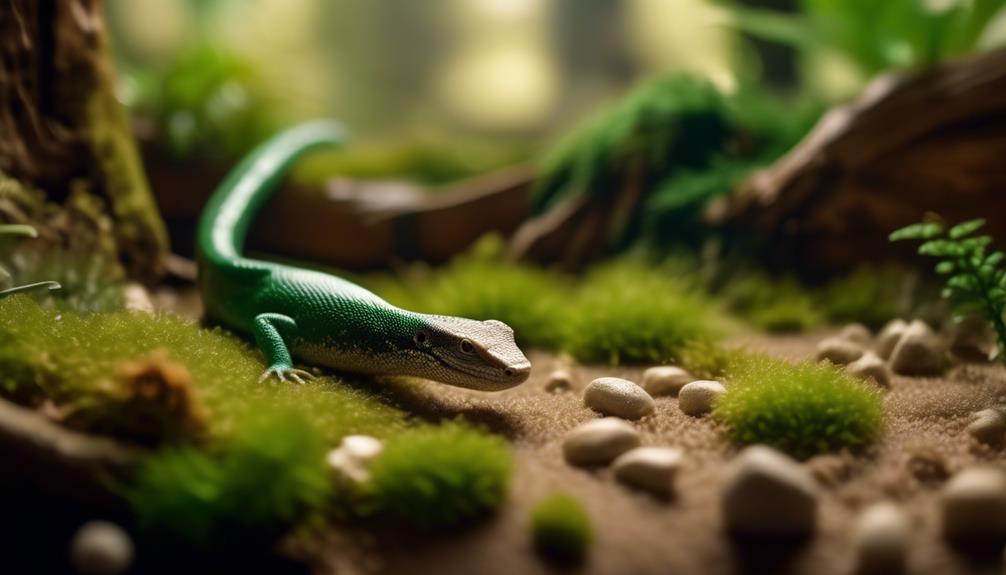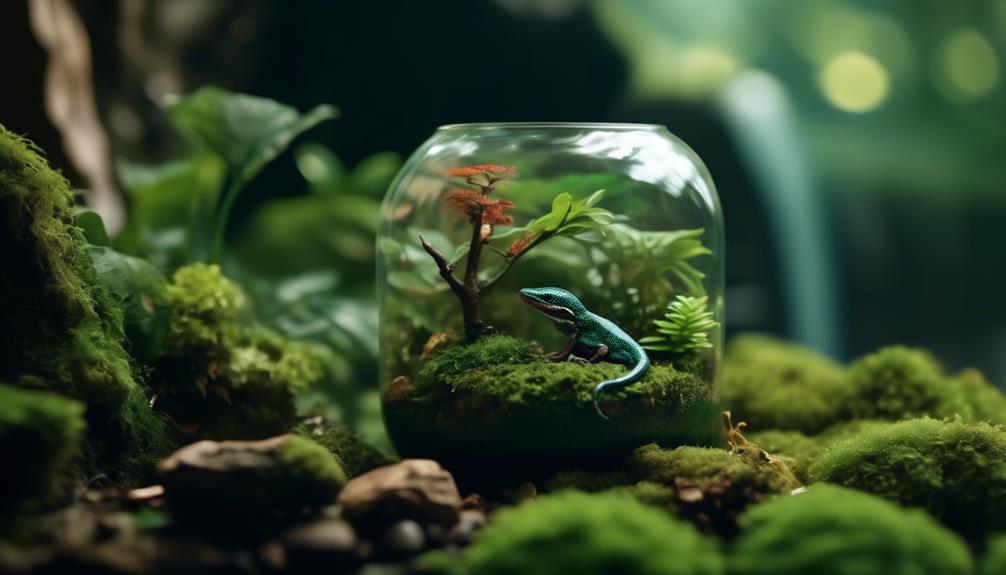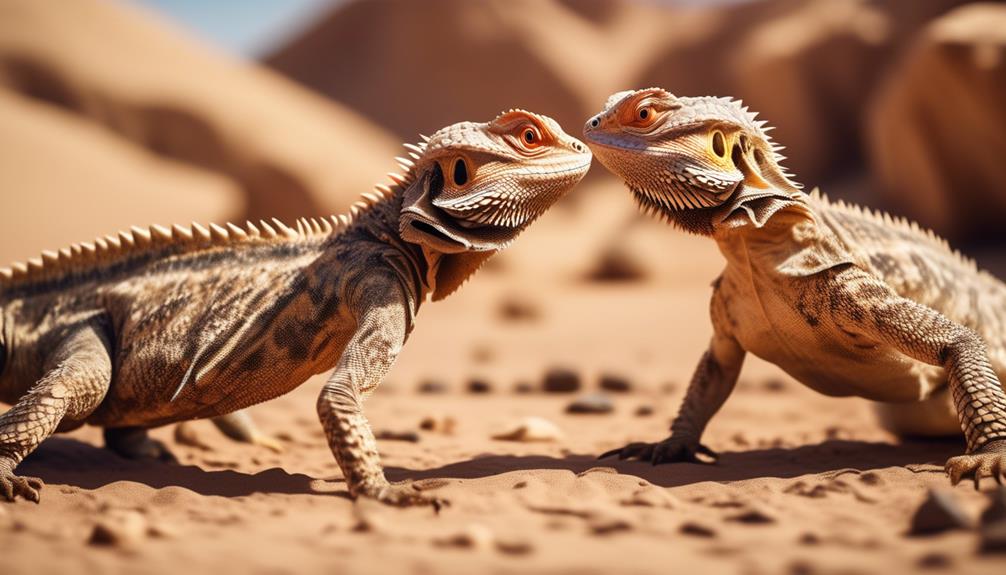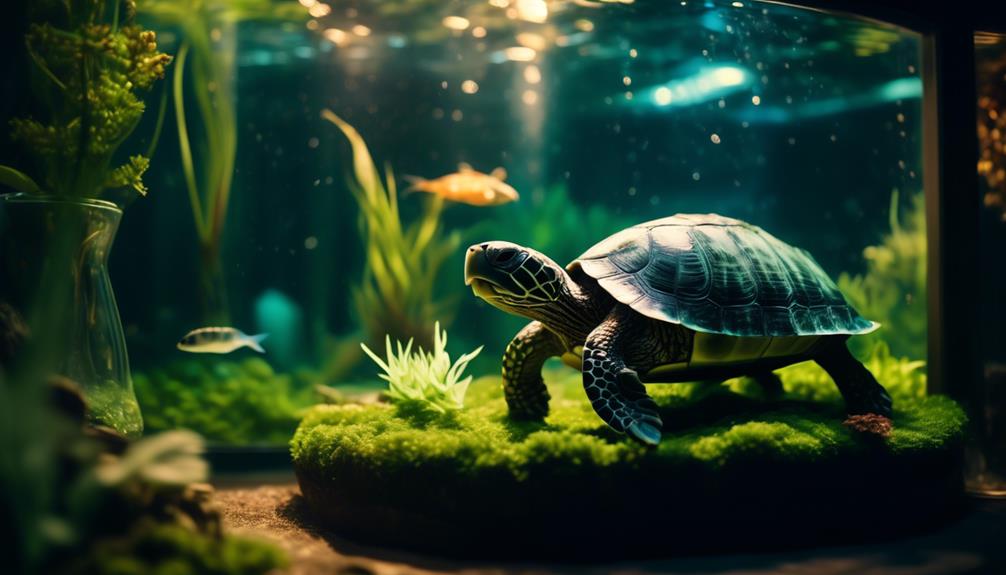Welcome to our ultimate guide on mastering care for Emerald tree skinks! Get ready to embark on an extraordinary journey of knowledge and expertise as we uncover the secrets to ensuring the utmost well-being of these captivating reptiles.
From creating the perfect habitat to understanding their unique needs, this comprehensive guide will equip you with the essential tools to become a skilled caretaker for your Emerald tree skinks.
But that's not all – we have some surprising insights and expert tips waiting for you.
So, are you ready to discover the key to unlocking the ultimate care for your Emerald tree skinks? Let's dive in!
Key Takeaways
- Emerald tree skinks need a spacious terrarium with plenty of room for running and climbing, with a minimum size of 18 x 18 x 36 inches.
- Cohabitation of skinks is optional but tends to work well, except for males and females which should only be housed together for breeding purposes.
- Emerald tree skinks require exposure to UVB light for survival, and recommended UVB bulbs include the Arcadia ShadeDweller Kit and Arcadia T5 HO 6%, 22.
- The basking temperature should be around 95°F, with a cooler area on the opposite side of the enclosure ranging from 75-85°F. A sturdy branch should be provided as a basking surface, and a halogen heat lamp is recommended.
Space and Housing Requirements

Emerald tree skinks require ample space for running, climbing, and overall wellbeing in their terrarium. To ensure their comfort, the minimum terrarium size should be 18 x 18 x 36 inches, although larger enclosures are recommended for better overall wellbeing.
When it comes to cohabitation, keeping multiple skinks together is feasible but optional. However, it's important to note that males and females shouldn't be housed together unless for breeding purposes.
UVB Lighting Requirements
To ensure the survival and overall health of emerald tree skinks, it is crucial to provide them with the necessary exposure to UVB lighting. UVB light is essential for these reptiles as it aids in the production of vitamin D3, which is vital for calcium absorption and bone health. While natural sunlight has its advantages, it is often not sufficient for emerald tree skinks due to the blocking of UVB rays by glass and plastic. Therefore, it is recommended to use UVB bulbs specifically designed for reptiles. These bulbs should be housed in reflective fixtures to maximize the distribution of UVB light throughout the terrarium. Here is a table showcasing some recommended UVB bulbs:
| UVB Bulb | Recommended for |
|---|---|
| Arcadia ShadeDweller Kit | Smaller terrariums |
| Arcadia T5 HO 6%, 22 | Larger terrariums |
Basking Temperature

For optimal basking temperature, it's important to provide emerald tree skinks with a stable heat source and a designated area within their enclosure. The ideal basking temperature for these reptiles is 95°F, which should be measured using a digital probe thermometer.
It's crucial to ensure that the basking surface is a sturdy branch, as this will allow the skinks to properly absorb heat and regulate their body temperature. It's recommended to use a halogen heat lamp for basking, avoiding ceramic heat emitters or colored bulbs.
Additionally, it's essential to provide a cooler area on the opposite side of the enclosure, with temperatures ranging between 75-85°F.
Maintaining the correct basking temperature and providing the proper basking surface will contribute to the overall well-being and health of your emerald tree skinks.
Humidity Levels
Maintaining the appropriate humidity levels is crucial for the health and well-being of emerald tree skinks. These tropical reptiles thrive in high humidity environments, so it's important to provide them with the right conditions.
Here are some key points to keep in mind when it comes to humidity levels for your emerald tree skinks:
- Misting techniques: Regularly misting the enclosure in the morning and evening is an effective way to maintain humidity. This not only helps to keep the humidity levels up, but it also provides a source of drinking water for the skinks.
- Hygrometer calibration: It's important to calibrate your hygrometer to ensure accurate readings of the humidity levels in the enclosure. This can be done by following the manufacturer's instructions or using a calibration kit. Regular calibration will help you monitor and adjust the humidity levels effectively.
- Proper monitoring: Use a digital probe hygrometer to measure and monitor the humidity levels in the enclosure. Aim for an average humidity of around 70% during the day and near 100% at night to create the optimal environment for your emerald tree skinks.
Substrate Options

After discussing the importance of maintaining appropriate humidity levels for emerald tree skinks, let's now explore the various substrate options that can provide them with a suitable habitat. The substrate should imitate tropical soil and hold moisture well. Some recommended substrates include Zoo Med Eco Earth, Zoo Med ReptiSoil, Exo Terra Plantation Soil, and Zilla Jungle Mix. To give the enclosure a more natural feel, layering clean leaf litter on top of the substrate can help with humidity maintenance. Leaf litter benefits the skinks by providing them with hiding spots and creating a more realistic environment. It is important to regularly maintain the substrate to ensure the health and well-being of the skinks. The substrate should be at least 2 inches deep and completely replaced every 3-4 months. Additionally, it is crucial to remove any waste and contaminated substrate on a daily basis. By maintaining the substrate properly, you can create a comfortable and safe environment for your emerald tree skinks.
| Substrate Options | |||
|---|---|---|---|
| Zoo Med Eco Earth | Zoo Med ReptiSoil | Exo Terra Plantation Soil | |
| Zilla Jungle Mix |
Frequently Asked Questions
What Is the Lifespan of an Emerald Tree Skink?
The lifespan of emerald tree skinks can vary depending on various factors. Factors affecting their lifespan include diet, habitat conditions, and overall care. It is important to provide proper nutrition, a suitable environment, and regular veterinary check-ups to maximize their lifespan.
Can Emerald Tree Skinks Be Kept With Other Reptiles or Amphibians?
Keeping emerald tree skinks with other reptiles or amphibians can be risky due to different care requirements and potential aggression. Compatibility issues arise, making multi-species enclosures challenging and potentially detrimental to the well-being of the skinks and other animals.
How Often Should Emerald Tree Skinks Be Fed and What Should Their Diet Consist Of?
Emerald tree skinks should be fed every 1-2 days, with a diet consisting of live insects such as crickets, roaches, and mealworms. Gut-loading and dusting the insects with calcium and vitamin supplements ensures optimal nutrition.
Are Emerald Tree Skinks Prone to Any Specific Health Issues or Diseases?
Emerald tree skinks can be prone to various health issues, such as respiratory infections, metabolic bone disease, and parasites. Regular veterinary check-ups, proper nutrition, and maintaining a clean environment are crucial for prevention and treatment.
Do Emerald Tree Skinks Require Any Specific Supplements or Vitamins?
Emerald tree skinks require specific supplements to ensure their nutritional needs are met. Calcium and vitamin D3 are crucial for bone health, while multivitamin supplements provide essential vitamins and minerals. Consult a reptile veterinarian for proper dosage and administration.
Conclusion
In conclusion, by following the guidelines and information provided in this comprehensive guide, you'll be able to create the perfect environment for your Emerald tree skinks.
With ample space, proper UVB lighting, appropriate temperature control, and optimal humidity levels, these fascinating reptiles will thrive in their terrarium.
Remember, providing the best care for your Emerald tree skinks is like tending to a delicate tropical garden, ensuring their health and happiness for years to come.


